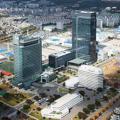
It's that time when the big names in consumer electronics report their latest sales figures, and there's a mixed picture, with Japanese companies recovering from the effects of the March earthquake and tsunami, and even the Korean giants being affected by changing market conditions.
Samsung (above) has today reported its figures for the first last quarter, and given an overview of how it's been doing in the first half of this year: and while sales are up on both measures, operating profit is down, not least due to falling prices caused by oversupply in the LCD panel and semiconductor markets.
Total sales for the period from April to June were KRW39.44tn, or about £22.7bn, which was up 4.1% on the same period last year. However, operating profit was down over 25% year on year, at around KRW3.75 (£2.16bn).
The good news is that sales and profit figures are up 6.6% and 27.3% respectively on the first quarter of this year; the bad is that while sales for the first six months were up 5.4% on the first half of 2010, at KRW76.42tn (just over £44bn), profits were down by almost 29%.
And the LCD division played a major part in that: in the last three months it achieved sales of KRW7.09tn (just over £4bn), but made an operating loss of KRW210bn (£121m), making this its second consecutive loss-making quarter.
Propping things up was the company's mobile phone business, which increased sales by 43% year-on-year in the past three months, and profits 166%.
Things look a bit rosier at LG, which showed increases in both sales and profits for the past three months. Sales were KRW14.39tn (almost £8.3bn), up 9.3% on the previous quarter, and profits up almost 21% at KRW158.2bn (£91m).
Meanwhile, in Japan...
In Japan, figures from Sony and Panasonic show the effects of the March earthquake and tsunami, which impacted both on production capacity and consumer demand: both companies showed a loss on the first quarter of the current financial year – the same April-June period Korean companies confusingly call Q2.
Sony recorded a net loss of Y15.5bn (£122m) in the April-June quarter, down from a profit of Y25.7bn (£202m) in the first three months of this year. Operating profit was also more than halved on the same period last year, on revenues down about 10% to Y1.49tn (£11.73bn).
And while the company has downgraded its forecast for the entire current financial year to a net profit of Y60bn (£472m), 25% less than it was expecting when it last made a forecast in May, it says it's a sign of how fast the economy is recovering that it's still expecting to make a profit, whereas last year it showed a loss of Y260bn, or around £2bn.
Panasonic, meanwhile, made a net loss of Y30.35bn (£239m) in April-June, down from a profit of Y43.68bn (£344m) in the same period last year. Operating profit fell over 90% to just Y5.58bn £44m), on revenue down 11%, with the company saying it suffered damage to production facilities in the March disaster, disruption to parts and materials supplies, and was also affected by price competition in the face of rising materials costs.
For the entire 2011-12 financial year, the company is forecasting revenues to stay almost static at Y8.7tn (£68.5bn), while operating profit will decline 12% to Y270bn (£2.12bn), and net profit down 59% to just Y30bn (£236m).
However, the company is making plans to cut some more costs out of this business, selling part of Sanyo to Chinese company Haier. Haier will take over the manufacture of the company's 'white goods' – washing machines and fridges – operation for Japan and Southeast Asia: it's already the world's top fridge manufacturer, with 13% of the global market, and in second place in washing machines, with a 9% share.
Most of the 2000 employees in Sanyo's white goods division will transfer to Haier under the deal, and it will free up resources at Panasonic and Sanyo, which are expected to complete a full merger next year, to concentrate on sustainable energy products such as solar panels.
Panasonic already has plans to use its plasma TV panel plant at Amagasaki to make next-generation solar panels, starting in the next year or so: it aims to lead the solar energy business in Japan within the next couple of years, and being among the top three global companies in the field by 2015.
